Public Service Enterprise Group Bundle
How has Public Service Enterprise Group shaped the energy landscape?
Public Service Enterprise Group (PSEG) boasts a rich history, evolving from a local utility to a major energy player. Its story is a testament to innovation and adaptation in a constantly changing industry. Founded in New Jersey in 1903, PSEG's journey offers valuable insights for investors and strategists alike.
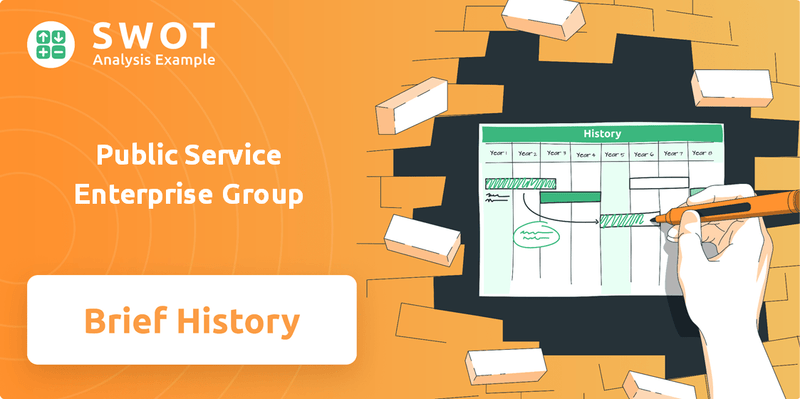
From its inception as Public Service Corporation, PSEG consolidated gas, electric, and transportation utilities, setting the stage for its future. Today, as a leading Public Service Enterprise Group SWOT Analysis reveals, PSEG's subsidiaries, including Public Service Electric & Gas Co. (PSE&G) and PSEG Power, serve millions, demonstrating its enduring impact. This brief history of PSEG explores its growth, challenges, and its pivotal role in the energy sector.
What is the Public Service Enterprise Group Founding Story?
The story of Public Service Enterprise Group (PSEG) began on June 1, 1903, when it was formally established as the Public Service Corporation. This marked the beginning of a journey for the energy company, evolving from a collection of smaller utilities into a major player in the industry. The company's early years were defined by a vision to consolidate and improve essential services for the people of New Jersey.
The driving force behind PSEG's creation was a group of influential New Jersey businessmen and financiers. Thomas N. McCarter, a key figure in this group, became the first president, bringing his legal, financial, and industrial expertise to the forefront. Their aim was to create a more efficient and reliable utility system, addressing the fragmented state of gas, electric, and street railway services at the time. This foundational strategy set the stage for PSEG's long-term growth and impact on the region.
The founders saw an opportunity to unify the scattered utility landscape in New Jersey. The goal was to create a single, centrally managed entity that could provide better services at more affordable rates. This approach involved acquiring and merging various independent companies, a strategy that would help PSEG achieve economies of scale and operational efficiencies. The choice of the name 'Public Service Corporation' reflected the company's commitment to serving the public good.
PSEG's initial business model focused on integrating and optimizing gas, electric, and transportation services. The company's early success was fueled by strategic acquisitions and infrastructure improvements.
- The initial funding for this consolidation came from private investments and the issuance of bonds and stock.
- A major hurdle during the establishment was navigating the complex regulatory environment.
- Securing approvals for mergers and acquisitions required extensive negotiations.
- The benefits of consolidation for consumers and economic development were clearly articulated.
The company's early financial strategy involved securing capital through a mix of private investments, bonds, and stock offerings. This funding was crucial for acquiring and merging the numerous existing franchises. A significant challenge during its establishment was managing the complex regulatory environment, which involved extensive negotiations. PSEG's ability to articulate the advantages of consolidation was key to gaining approvals and supporting New Jersey's economic growth. PSEG's history reflects a commitment to adapting and innovating to meet the evolving needs of its customers and the state. For more details on the company's values, consider reading about the Mission, Vision & Core Values of Public Service Enterprise Group.
Public Service Enterprise Group SWOT Analysis
- Complete SWOT Breakdown
- Fully Customizable
- Editable in Excel & Word
- Professional Formatting
- Investor-Ready Format
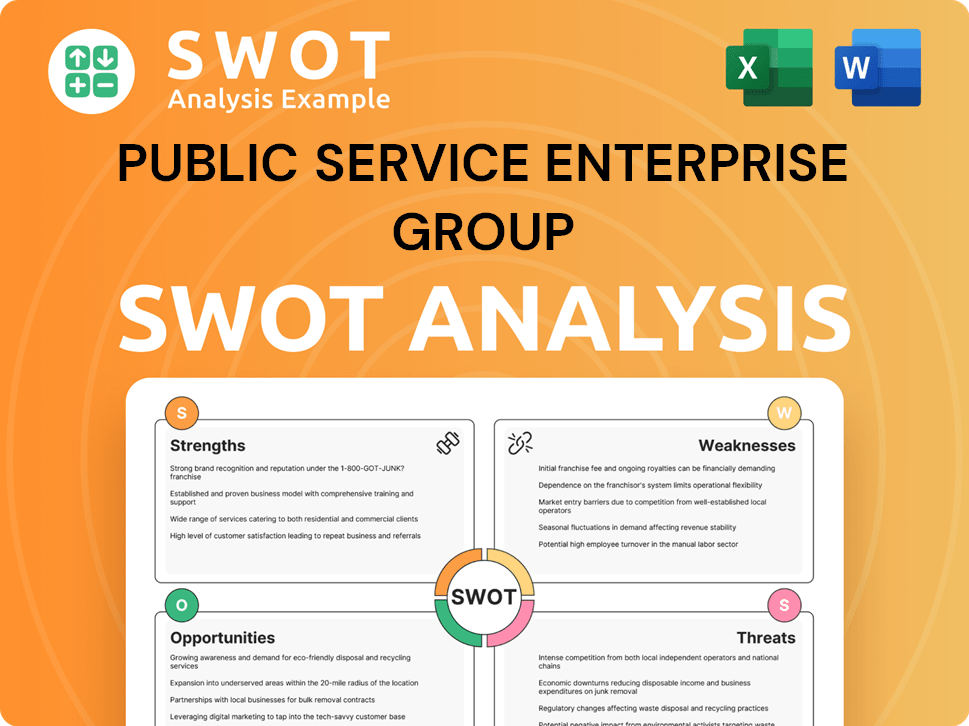
What Drove the Early Growth of Public Service Enterprise Group?
The early years of Public Service Enterprise Group (PSEG) were marked by rapid expansion and consolidation. Following its 1903 founding, the company quickly acquired numerous gas, electric, and transportation entities. This aggressive strategy laid the groundwork for PSEG's dominance in New Jersey's utility sector, setting the stage for its future as a leading energy company.
PSEG's initial strategy focused on acquiring smaller companies. By 1910, the company had already consolidated over 400 gas, electric, and transportation businesses. This rapid expansion was crucial for establishing its market presence and influence within New Jersey. The company's early success was built on this aggressive acquisition approach.
Early product launches centered on standardizing and expanding gas and electric services. This included introducing electric streetlights and extending gas lines to both residential and commercial areas. PSEG's focus was on making these essential services widely available across its growing service territory. This expansion helped to solidify its role as a key utility provider.
The initial workforce expansion involved integrating employees from acquired companies. PSEG's early infrastructure consisted of existing power plants, gasworks, and streetcar depots, which were modernized and expanded. These facilities formed the backbone of its operations, supporting the delivery of essential services. Owners & Shareholders of Public Service Enterprise Group benefited from these early investments.
Thomas N. McCarter provided continued leadership during the early decades, guiding the company through significant growth and technological advancements. Major capital raises were achieved through bond issuances and stock offerings. These financial strategies were critical for funding the extensive infrastructure development needed for electrification and gas distribution, fueling PSEG's expansion.
Public Service Enterprise Group PESTLE Analysis
- Covers All 6 PESTLE Categories
- No Research Needed – Save Hours of Work
- Built by Experts, Trusted by Consultants
- Instant Download, Ready to Use
- 100% Editable, Fully Customizable
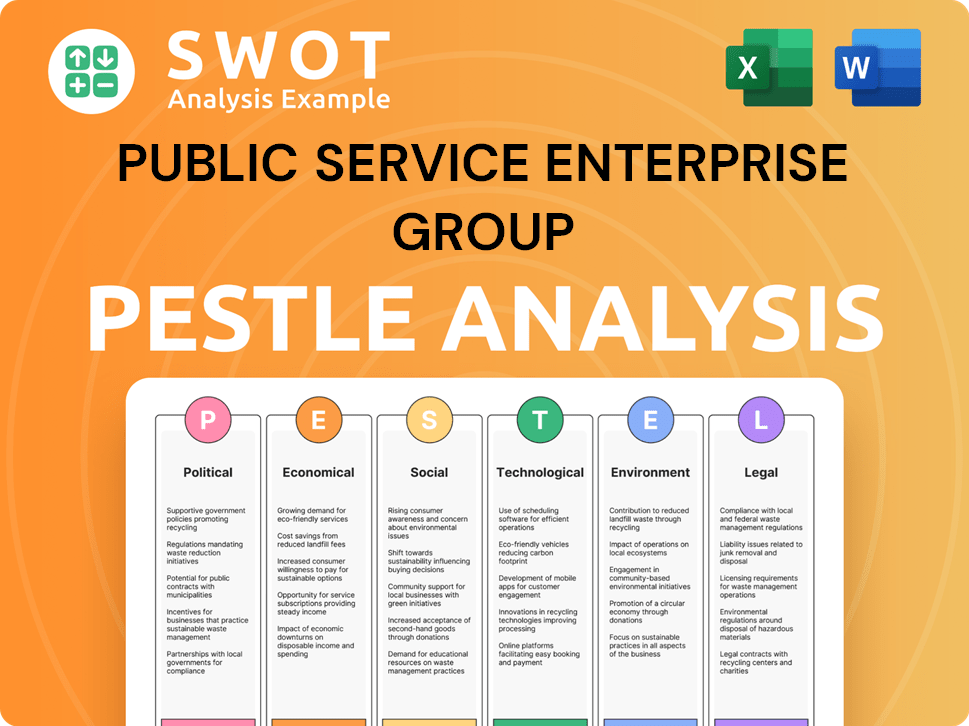
What are the key Milestones in Public Service Enterprise Group history?
Throughout its history, Public Service Enterprise Group (PSEG) has achieved numerous milestones, reflecting its growth and adaptation within the energy sector. These achievements highlight the company's evolution and its impact on the communities it serves.
| Year | Milestone |
|---|---|
| 1903 | The company was founded as Public Service Corporation, marking its entry into the utility business in New Jersey. |
| Early 20th Century | PSEG pioneered the development of large-scale, centralized power generation, enhancing efficiency and reliability. |
| Mid-20th Century | PSEG expanded its service territory and infrastructure, becoming a key provider of electricity and natural gas. |
| Late 20th Century | The company adapted to deregulation and market changes, diversifying its operations. |
| 2000s-2024 | PSEG focused on its regulated utility business and invested in clean energy initiatives, including offshore wind projects. |
PSEG has consistently demonstrated innovation in its approach to energy generation and distribution. Early adoption of advanced technologies and strategic partnerships have been hallmarks of its operational strategy.
PSEG moved away from smaller, localized plants to large-scale, centralized power generation, improving efficiency and reliability. This shift was crucial for meeting the growing energy demands of its service areas.
The company secured numerous patents related to power generation and distribution technologies. These innovations helped to improve the efficiency and safety of its operations.
Major partnerships included collaborations with industrial giants for power supply and infrastructure development. These alliances supported PSEG's expansion and technological advancements.
PSEG has received recognition for its commitment to sustainability, consistently ranking among top utilities in various industry benchmarks. This includes investments in renewable energy sources and grid modernization.
PSEG has faced various challenges throughout its history, including economic downturns and competitive pressures. These obstacles have required strategic adjustments and a focus on adaptability.
Economic events, such as the Great Depression, significantly impacted demand and revenue, necessitating cost-cutting measures. PSEG had to adapt its strategies to navigate these challenging economic conditions.
Deregulation in the energy sector led to increased competition in power generation and supply. PSEG responded by focusing on its core utility business and adapting to market changes.
The company has had to adapt to changing energy sources and technologies, moving from coal-fired plants to more natural gas and renewable energy sources. This transition required significant investment and strategic planning.
Internal crises, including labor disputes and infrastructure challenges, have tested the company's resilience. PSEG has addressed these issues through strategic leadership and operational improvements.
PSEG has undertaken major strategic pivots, including the divestiture of its non-utility assets to focus on its regulated utility and clean energy transition. This has involved investments in offshore wind projects and grid modernization.
Public Service Enterprise Group Business Model Canvas
- Complete 9-Block Business Model Canvas
- Effortlessly Communicate Your Business Strategy
- Investor-Ready BMC Format
- 100% Editable and Customizable
- Clear and Structured Layout
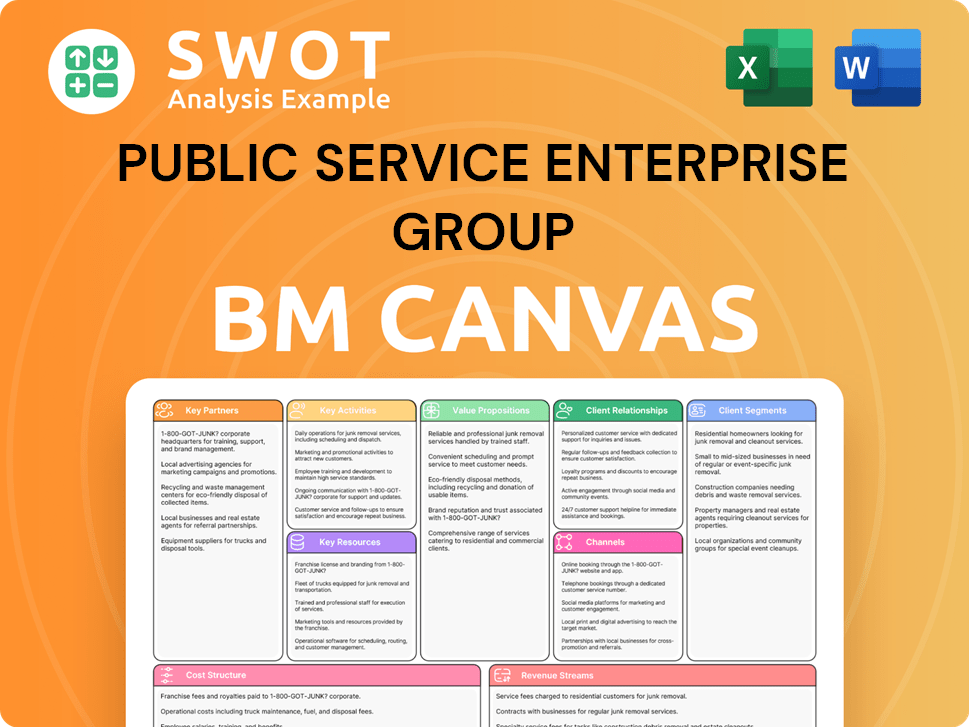
What is the Timeline of Key Events for Public Service Enterprise Group?
The story of Public Service Enterprise Group (PSEG), a significant energy company and utility company in New Jersey, is marked by strategic shifts and adaptation to the evolving energy landscape. From its beginnings in the early 20th century to its current focus on clean energy, PSEG's evolution reflects broader trends in the utility sector. The company's history, including its founding, mergers, and acquisitions, showcases its growth and influence within the region. Its transformation underscores the importance of innovation and sustainability in the energy sector, shaping its role in the future.
| Year | Key Event |
|---|---|
| 1903 | Public Service Corporation is founded, consolidating various gas, electric, and transportation companies in New Jersey. |
| 1924 | The company is reorganized as Public Service Electric and Gas Company (PSE&G). |
| 1950s-1960s | Significant expansion of power generation capacity with the construction of large fossil fuel plants. |
| 1970s | Entry into nuclear power generation with the construction of Salem and Hope Creek nuclear plants. |
| 1980s | Diversification into non-utility businesses. |
| 1990s | Deregulation of the energy market leads to the formation of PSEG Power, an independent power producer. |
| 2000s | Increased focus on environmental initiatives and renewable energy investments. |
| 2010 | PSEG Power becomes a major player in the wholesale energy market. |
| 2020 | PSEG announces its strategic shift to a primarily regulated utility and clean energy infrastructure company, including the sale of its non-nuclear generation assets. |
| 2023-2025 | Continued investment in offshore wind projects, grid modernization, and electric vehicle infrastructure. |
For 2024, PSEG's capital expenditures are projected to be around $3.3 billion. This investment is mainly directed towards PSE&G's transmission and distribution infrastructure and clean energy projects. This substantial investment reflects the company's commitment to modernizing its infrastructure and advancing its clean energy initiatives, which aligns with broader industry trends.
PSEG is heavily focused on the clean energy transition. The company aims to achieve net-zero greenhouse gas emissions from its operations by 2030. This goal is supported by significant investments in renewable energy sources and energy efficiency programs. The company's strategic direction is influenced by increasing electrification and decarbonization goals.
PSEG is actively involved in offshore wind development, particularly the Ocean Wind 1 and Ocean Wind 2 projects. These projects are expected to provide substantial renewable energy to New Jersey. The company's commitment to offshore wind aligns with its broader strategy to expand its renewable energy portfolio and reduce its carbon footprint.
PSEG is committed to modernizing its electric and gas infrastructure to enhance reliability and integrate more renewable energy sources. The company is exploring advanced energy storage solutions and smart grid technologies. These innovations are crucial for supporting the growing demand for electric vehicles and improving grid resilience.
Public Service Enterprise Group Porter's Five Forces Analysis
- Covers All 5 Competitive Forces in Detail
- Structured for Consultants, Students, and Founders
- 100% Editable in Microsoft Word & Excel
- Instant Digital Download – Use Immediately
- Compatible with Mac & PC – Fully Unlocked
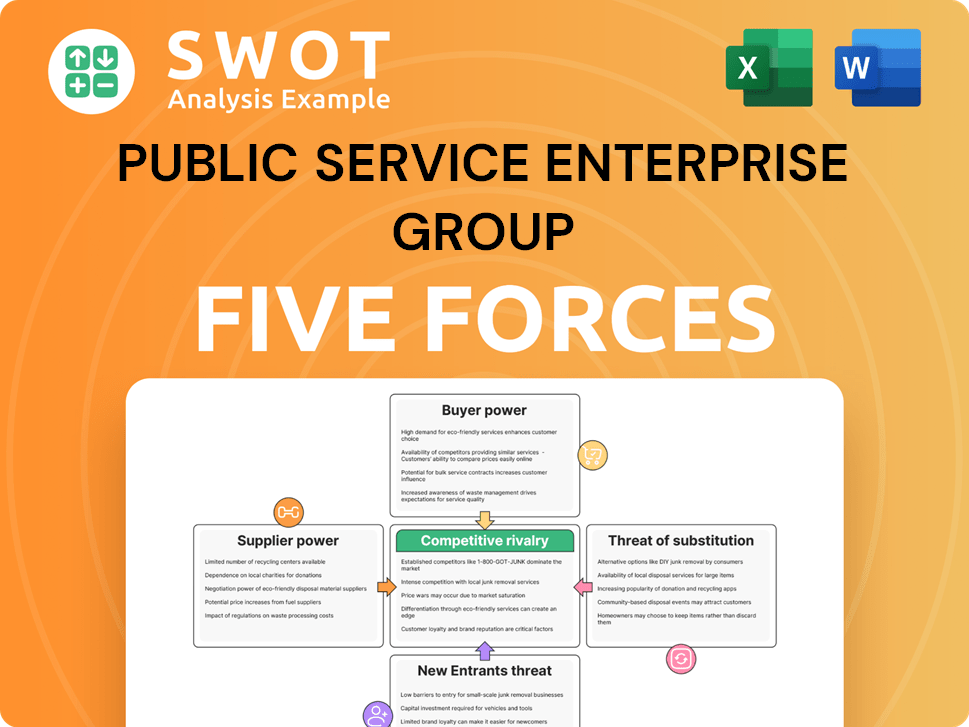
Related Blogs
- What is Competitive Landscape of Public Service Enterprise Group Company?
- What is Growth Strategy and Future Prospects of Public Service Enterprise Group Company?
- How Does Public Service Enterprise Group Company Work?
- What is Sales and Marketing Strategy of Public Service Enterprise Group Company?
- What is Brief History of Public Service Enterprise Group Company?
- Who Owns Public Service Enterprise Group Company?
- What is Customer Demographics and Target Market of Public Service Enterprise Group Company?
Disclaimer
All information, articles, and product details provided on this website are for general informational and educational purposes only. We do not claim any ownership over, nor do we intend to infringe upon, any trademarks, copyrights, logos, brand names, or other intellectual property mentioned or depicted on this site. Such intellectual property remains the property of its respective owners, and any references here are made solely for identification or informational purposes, without implying any affiliation, endorsement, or partnership.
We make no representations or warranties, express or implied, regarding the accuracy, completeness, or suitability of any content or products presented. Nothing on this website should be construed as legal, tax, investment, financial, medical, or other professional advice. In addition, no part of this site—including articles or product references—constitutes a solicitation, recommendation, endorsement, advertisement, or offer to buy or sell any securities, franchises, or other financial instruments, particularly in jurisdictions where such activity would be unlawful.
All content is of a general nature and may not address the specific circumstances of any individual or entity. It is not a substitute for professional advice or services. Any actions you take based on the information provided here are strictly at your own risk. You accept full responsibility for any decisions or outcomes arising from your use of this website and agree to release us from any liability in connection with your use of, or reliance upon, the content or products found herein.